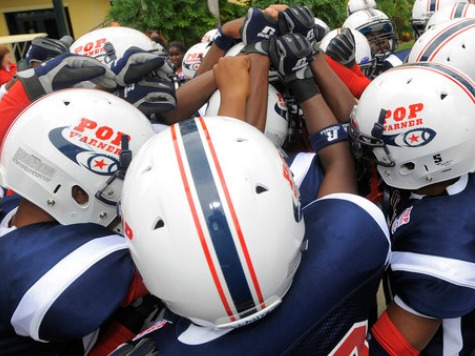A new two-year study of youth football players found that bruised appendages and torn ligaments, not concussions, were the injuries that most vexed young gridiron athletes over the last two seasons. Just one in twenty-five players suffered a concussion.
USA Football, a national youth football governing body established more than a decade ago with seed money from the NFL, commissioned the study carried out by the independent Datalys Center. The study looked at more than 4,000 players from the age of five to fourteen during the 2012 and 2013 seasons. The group released preliminary findings after the 2012 season.
The study found that about one tenth of all players missed a game or practice because of injury. The players sustained no catastrophic brain, spinal, or heat-related injuries during the two-year span, and 96 percent of the youth athletes escaped the mild traumatic brain injuries that haven’t escaped the interest of journalists covering the sport.
The most common injuries were bruises followed by sprains. Just twelve percent of the players missed a game or practice because of an injury. The rate of injury in games proved higher than in practices.
The findings mesh with other recent studies suggesting that, although still a rough sport, football enjoys a safer game than it has in the past. Collision fatalities declined from about twenty-four a year during the 1960s to about four a year annually during the first decade of the twenty-first century.
Late last year, doctors and academics affiliated with Sanford Research and the University of South Dakota found substantial improvement in eye movement, balance, and cognitive function after a season of football. The pilot study concentrated on middle-school age players on one team.
A 2012 Mayo Clinic study of hundreds of mid-century high school football players found no real difference in neurodegenerative diseases between the athletes and their peers in the glee club, band, and choir. In fact, the musically-inclined students exhibited higher rates of Parkinson’s and Lou Gehrig’s disease.
Despite a growing body of research that conflicts with the media alarmism, parents show increasing reluctance in permitting their boys to play football. Last year, USA Football reported a seven percent decline in youth football participation from the previous season.
“The health of the millions of children who love to play football and gain its fitness and social benefits is our top priority,” maintained USA Football Executive Director Scott Hallenback in the group’s press release outlining the findings. “This research underscores that education changes behavior, which is a long-standing premise held by USA Football and medical experts.”

COMMENTS
Please let us know if you're having issues with commenting.